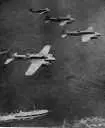The
Attack on Pearl Harbor
It was a Sunday morning. Many sailors were still sleeping in their quarters, aboard their ships. Some were sleeping on land. At 7:02 a.m. at the Opana Radar Station on Oahu, privates Joseph Lockhard & George Elliott saw something on their screen. It looked like a lot of planes flying toward them. Opana's was the only radar turned on just then, and it was on only for training. The other radar stations had been turned off. It was standard procedure. Following standard procedure, Lockhard and Elliott reported what they saw. (Click here for an eyewitness account of the attack.) The commanding officer on duty knew that a squadron of American planes was due in from California about the same time. Reasoning that what Lockhard and Elliott saw was that squadron of American planes, the commanding officer told the two privates not to worry. What they didn't know and what nobody in America knew was that Japanese planes had taken off at 6 a.m. from aircraft carriers 230 miles away. What nobody in America thought was possible was happening: The Japanese were attacking Pearl harbor.
A fleet of midget submarines was also part of the Japanese attack. These subs dropped deadly torpedoes, which had been modified with wooden fins to run their course in the shallow waters of Pearl Harbor. Next page > The Damage > Page 1, 2, 3 |
|
Social Studies for Kids
copyright 2002–2024
David White

 At
7:55, the Japanese attacked with deadly force. The first
wave of 183 planes dropped bombs and fired bullets at the
almost defenseless American ships in Pearl Harbor and planes
at three nearby airfields. A second wave of 167 planes
followed about an hour later. American sailors fought back,
struggling to get their planes off the ground and fire their
guns at targets they couldn't quite see.
At
7:55, the Japanese attacked with deadly force. The first
wave of 183 planes dropped bombs and fired bullets at the
almost defenseless American ships in Pearl Harbor and planes
at three nearby airfields. A second wave of 167 planes
followed about an hour later. American sailors fought back,
struggling to get their planes off the ground and fire their
guns at targets they couldn't quite see.

